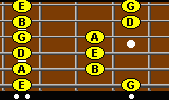Lesson 20
In this lesson we will look at octaves and review the other intervals we have learned. We will also work to connect all of our scale forms.
|

Tune Guitar
|
 An octave is the interval between the 1st and 8th degree of a major scale. Also, 12 half steps. An octave is the interval between the 1st and 8th degree of a major scale. Also, 12 half steps.
Use your 1st finger on the 2nd fret E and use your little finger on the 5th fret E. It is important to mute all strings but 2 and 4.
Let your pinky touch the 1st string. Gently, just enough to mute it.
Let your 1st finger touch the 3rd string slightly.
To stop strings 5 and 6 you will have to use your 2nd finger. |
 |
Review
1 half step = minor 2nd
2 half steps = major 2nd
3 half steps = minor 3rd
4 half steps = major 3rd
5 half steps = perfect 4th
6 half steps = tritone
|
7 half steps = perfect 5th
8 half steps = minor 6th
9 half steps = major 6th
10 half steps = minor 7th
11 half steps = major 7th
12 half steps = perfect 8th (octave)
|
The tritone is also known as a diminished 5th and an augmented 4th.
12 position E minor/G major pentatonic scale
| Could you turn this into a blues scale? You would have to add Bb's. |

|
Let us connect all of the scale forms we have learned so far. We will use the pentatonic shapes for easier recognition.

Play all of the notes in 7th position up and back down, shift to 9th position (use common finger) and run the scale up and back down, continue until you have covered all 4 positions. Use metronome and work on various rhythmic patterns.
Using the theory about the 1st chord representing the key doesn't work so well in this case. The D's played in the 1st guitar part are telling us that it isn't the key of E. The key of E has a D# . We do have some choices though.
E major pentatonic
If we made the E major scale pentatonic we would get rid of the 4th and 7th from the major scale. The 7th is the D#. E major pentatonic would then work.
E minor pentatonic
You may also want to try putting your index finger on the 12th fret E of your low E string and use the good ol 1-4, 1-3, 1-3 pattern. This gives us a very different sound then the E major pentatonic. This gives the solo a blues characteristic. Add the Bb's to your scale and you will have the E blues scale which sounds great too.
Key of A major
My favorite sound.
Try all of them. Spend a few minutes jammin with each and get familiar with the sound and feel created from each.
|
Lit - My Own Worst Enemy



|
 An octave is the interval between the 1st and 8th degree of a major scale. Also, 12 half steps.
An octave is the interval between the 1st and 8th degree of a major scale. Also, 12 half steps.



